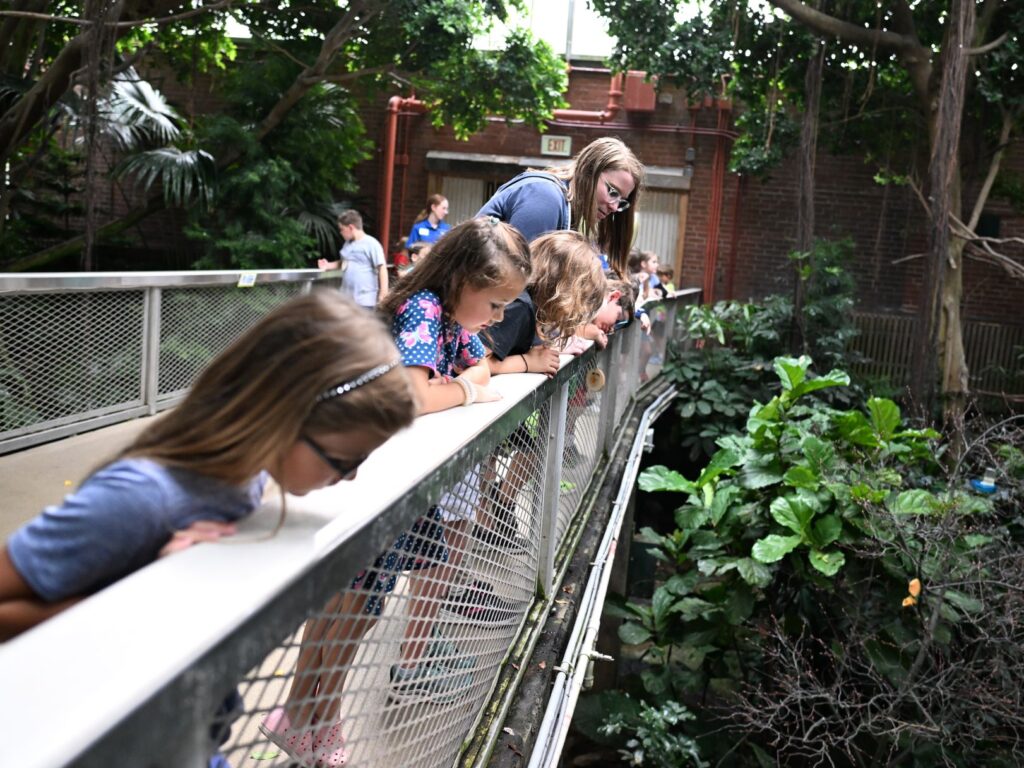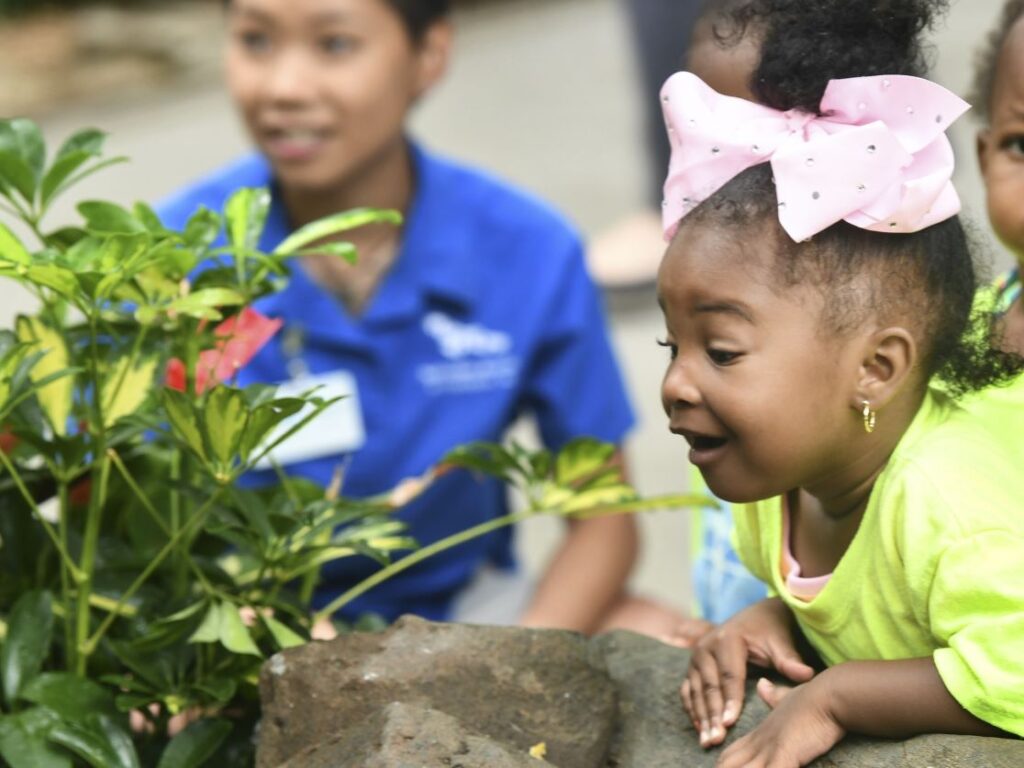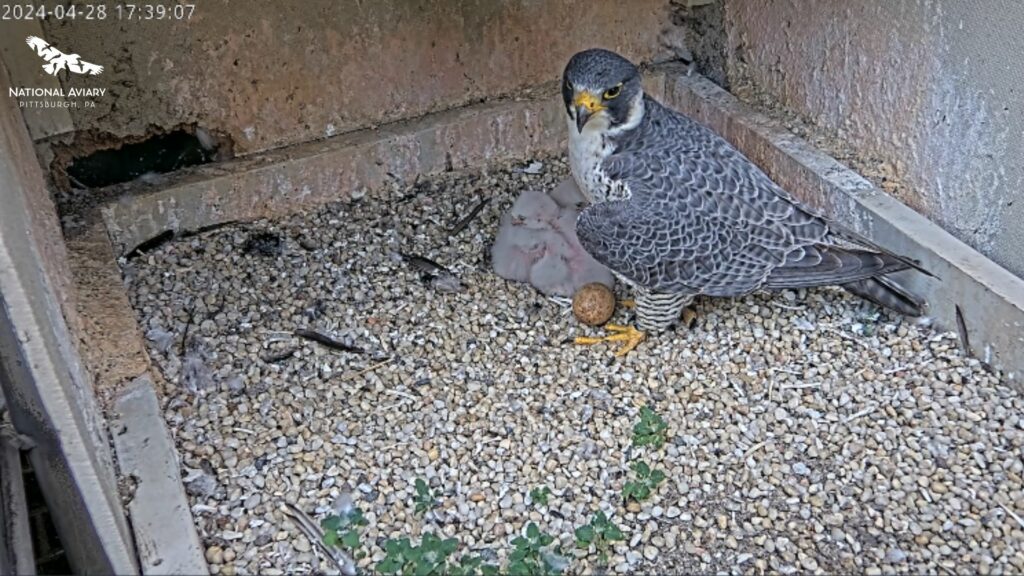National Aviary Peregrine FalconCam
Each spring and summer, the National Aviary hosts a live stream of the Peregrine Falcons residing high up on the southeast side of the Cathedral of Learning on the main campus of the University of Pittsburgh: the National Aviary’s Peregrine FalconCam.
Make the video full screen for the best view into the wild world of Peregrine Falcons! It’s important to remember that the Peregrine FalconCam gives us a view into the wild world of birds, and while it’s not our role to intervene, we can learn a lot from studying these behaviors.
2025 National Aviary Peregrine FalconCam Updates!
April 9, 2025: Most of the on-camera action has been, and will continue to be, Carla diligently incubating her eggs. As many National Aviary Peregrine FalconCam viewers may already know, the female does the bulk of the incubating, with the male stepping in about one-third of the time.
“Eagle-eyed” fans were treated to one such occasion last week when Ecco took over incubating duties. Prior to the change, both falcons were extremely vocal with one another, possibly signaling that Ecco had either brought Carla food or was ready for his “shift.” Carla briefly went off-camera before she returned to the perch and then resumed incubation.
Carla returning to incubation after Ecco briefly took over
The expected hatch date is April 23 – 25.
It’s important to remember that the Peregrine FalconCam gives us a view into the wild world of birds, and while it’s not our role to intervene, we can learn a lot from studying these behaviors.
March 25, 2025: One, two, three…FOUR eggs can now be seen on the National Aviary’s Peregrine FalconCam! Wild Peregrine Falcon, Carla, laid her fourth egg in the early hours of March 25 around 2:07 am EST. Ecco even visited Carla (and all four eggs!) around 7 am EST.
Peregrine Falcon clutches typically consist of four eggs, and their incubation period is 33-34 days; it’s likely that we will see more of Carla on camera as she begins the incubation process. During this time, Ecco will help Carla by bringing her food and incubating the eggs one-third of the time.
It’s important to remember that these nest cams give us a view into the wild world of birds, and while it’s not our role to intervene, we can learn a lot from studying these behaviors.
March 21, 2025: The more the merrier! Carla and Ecco’s THIRD egg was laid at 2:07 am EST on March 21. Peregrine Falcon incubation typically begins when the female has laid her next-to-last egg…will Carla lay any more eggs? Stay tuned to find out!
It’s important to remember that these nest cams give us a view into the wild world of birds, and while it’s not our role to intervene, we can learn a lot from studying these behaviors.
March 18, 2025: Just in time for the first day of Spring (Thursday, March 20)…Carla and Ecco have a SECOND egg! Carla laid this egg on Tuesday, March 18 around 3:24 pm EST. As dedicated National Aviary Peregrine FalconCam viewers may already know, female Peregrine Falcons typically lay eggs roughly 48 hours apart. Once Carla lays her next-to-last egg, she will likely begin the incubating process.
It’s important to remember that these nest cams give us a view into the wild world of birds, and while it’s not our role to intervene, we can learn a lot from studying these behaviors.
March 17, 2025: This week kicks off with some egg-stra exciting news (talk about a lucky arrival just in time for Saint Patrick’s Day)!
The first egg of the National Aviary Peregrine FalconCam season has arrived – yesterday’s viewers may have spotted the deeply red-brown colored egg on the livestream a little after 1:17 pm EST when Carla laid it. This is the first of up to four eggs that Carla will likely lay. A Peregrine clutch can be three to six eggs, with the average being four. Carla will potentially lay one egg every 48 hours or so until her clutch is completed. Only after she lays her next to last egg, will she begin to incubate the clutch. Until then, it is perfectly safe for the eggs to be left uncovered as they have strong temperature tolerances meaning they can endure the inconsistent climate changes brought by the Spring season.
Carla and Ecco both will incubate their eggs, although the task is split unevenly, with Carla incubating the eggs about two-thirds of the time to Ecco’s one-third. It will take a little over a month for the eggs to begin hatching. Stay tuned for another eventful season!
It’s important to remember that the Peregrine FalconCam gives us a view into the wild world of birds, and while it’s not our role to intervene, we can learn a lot from studying these behaviors.
March 12, 2025: Carla and Ecco continue to partake in about four to five courtship displays per day. Recently, these displays have included beak-to-beak touching which is the bird-equivalent to elephant kisses – or when elephants interlock their trunks as a sign of social bonding and greeting (think of how you might greet your loved one with a hug when they come over for dinner!).
As the Pittsburgh weather begins to warm, viewers of the National Aviary Peregrine FalconCam will likely see Carla and Ecco spending more time at the nest, perching on their ledge, sunning their feathers, and continuing courtship behaviors. Keep an eye out for if/when Carla begins to stay in the nest overnight…that’s a good sign that she’s approaching egg-laying!
It’s important to remember that the Peregrine FalconCam gives us a view into the wild world of birds, and while it’s not our role to intervene, we can learn a lot from studying these behaviors.
February 26, 2025: When viewing the National Aviary Peregrine FalconCam, have you thought to yourself, “I wonder if that’s Carla or Ecco?”
Because females are larger than males, Peregrine Falcons (like other raptors) are considered sexually dimorphic – meaning there are physical differences between the two sexes. However, judging the size comparisons of Carla and Ecco is rather tricky when only one of them is on camera.
The easiest way to determine who is who is by looking at their ankles! While Ecco doesn’t have any bands, Carla does! She was banded (Black/Blue S/07) in 2020 at One Summit Square in Fort Wayne, Indiana. Another easy trick? Carla’s chest plumage has tiny specks of dark feathers while Ecco’s is strictly white. Check out the image below for a closer look at these differences!
…But what if the birds are facing away from the camera and you can’t see their ankles? Look closely at the tip of their wings! The tips of Ecco’s wings are lighter than his female counterpart. If it seems as if there is a clear light gray line around the wingtip – that’s Ecco! If it’s dark brown – that’s Carla!
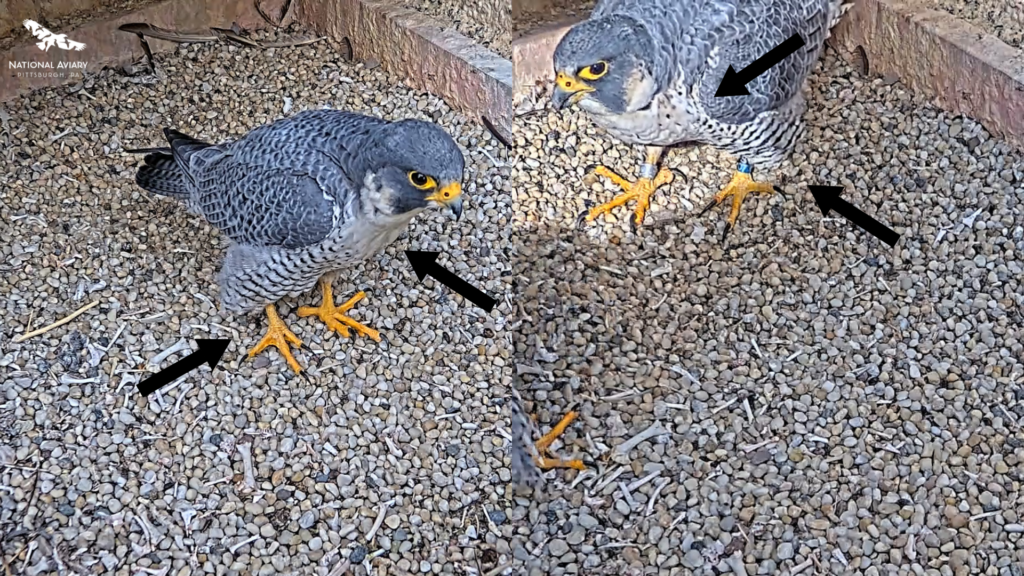
It’s important to remember that the Peregrine FalconCam gives us a view into the wild world of birds, and while it’s not our role to intervene, we can learn a lot from studying these behaviors.
February 11, 2025: With Valentine’s Day just a few days away, now is the perfect occasion to spotlight the growing bond between falcons Carla and Ecco. Last year, viewers of the National Aviary Peregrine FalconCam witnessed the pair’s first fruitful breeding season.
Peregrine Falcon nesting typically follows the same annual pattern. Viewers can expect to see Carla and Ecco’s courtship intensify through early March, with synchronized head gestures, bowing, and vocalizations known in the birding world as Mutual Ledge Displays. We may even see Ecco present food to Carla – similar to the “acts of service” love language seen in human relationships.
Valentine’s Day celebrates the deepening of human connections, just as watching Carla and Ecco’s courtship offers a unique chance to watch two Peregrine Falcons in the wild build a bountiful bond. Stay tuned as we give you a bird’s eye view of this pairing as it evolves in 2025.
February 1, 2025: National Aviary Peregrine FalconCam season is back!
ICYMI: 2024 was an exciting year for Peregrine pair Carla and Ecco. Not only was 2024 the first year for the new couple to occupy the nest box together; it also brought us not one but TWO chicks. Typically, falcon eggs hatch two to three days apart but memorably, Carla and Ecco’s chicks BOTH fittingly hatched on Earth Day. They grew under the watchful eyes of Mom, Dad, and faithful viewers like you.
In late May, as a part of an ongoing statewide effort to monitor once declining Peregrine Falcon populations – both chicks were banded by Pennsylvania Game Commission biologists (alongside National Aviary Ornithologist Bob Mulvihill, and staff members of the Aviary and the University of Pittsburgh)! A few weeks later, the chicks fledged their Cathedral of Learning nest – onto their next chapters in life.
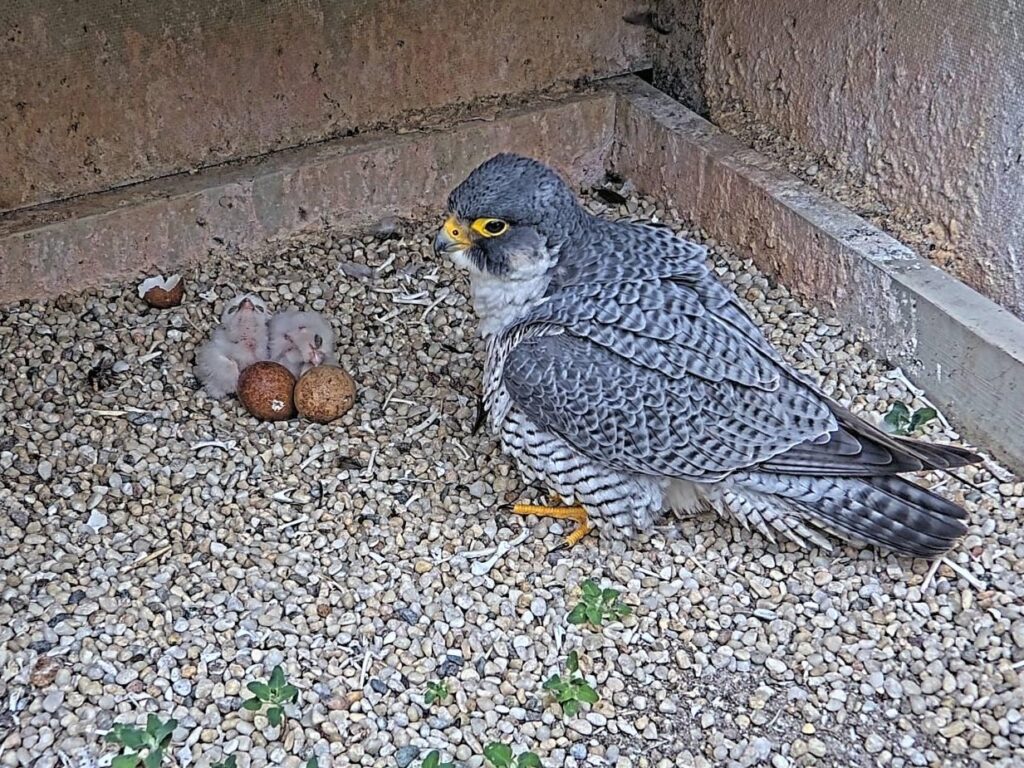
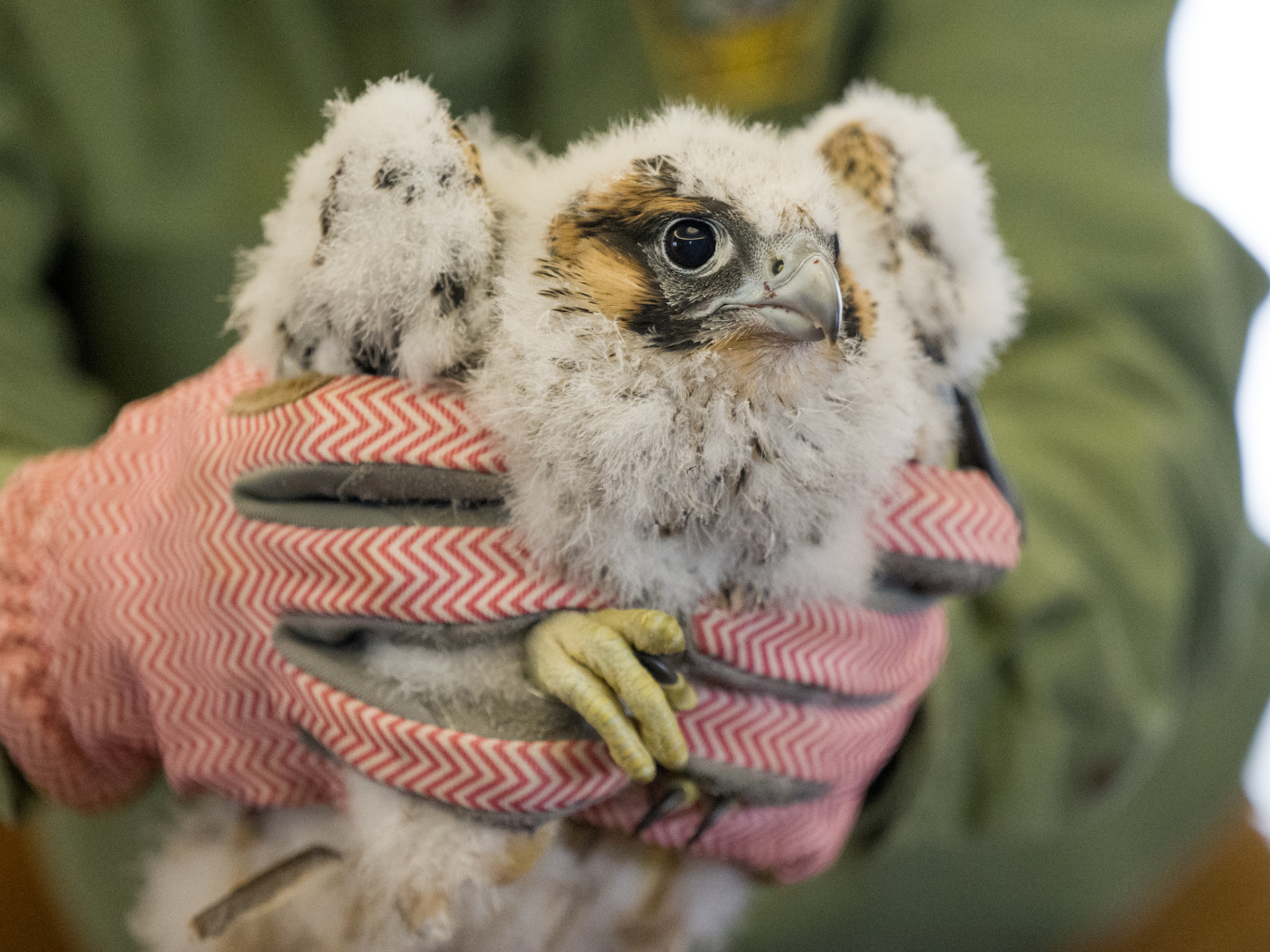
Not to mention, the new National Aviary Peregrine FalconCam technology made the larger-than-life season’s viewing experience even clearer to enjoy. The updated camera equipment allowed for a sharper focus, better reach, improved audio, and infrared night light. We extend a heartfelt thank you to our friends Kate St. John, the University of Pittsburgh, and Lighthouse Electric for assisting us with the major equipment upgrade. Stay tuned as we hopefully gear up for new, exciting developments and adorable hatchlings from Carla and Ecco in 2025.
Meet a Falcon Up Close!
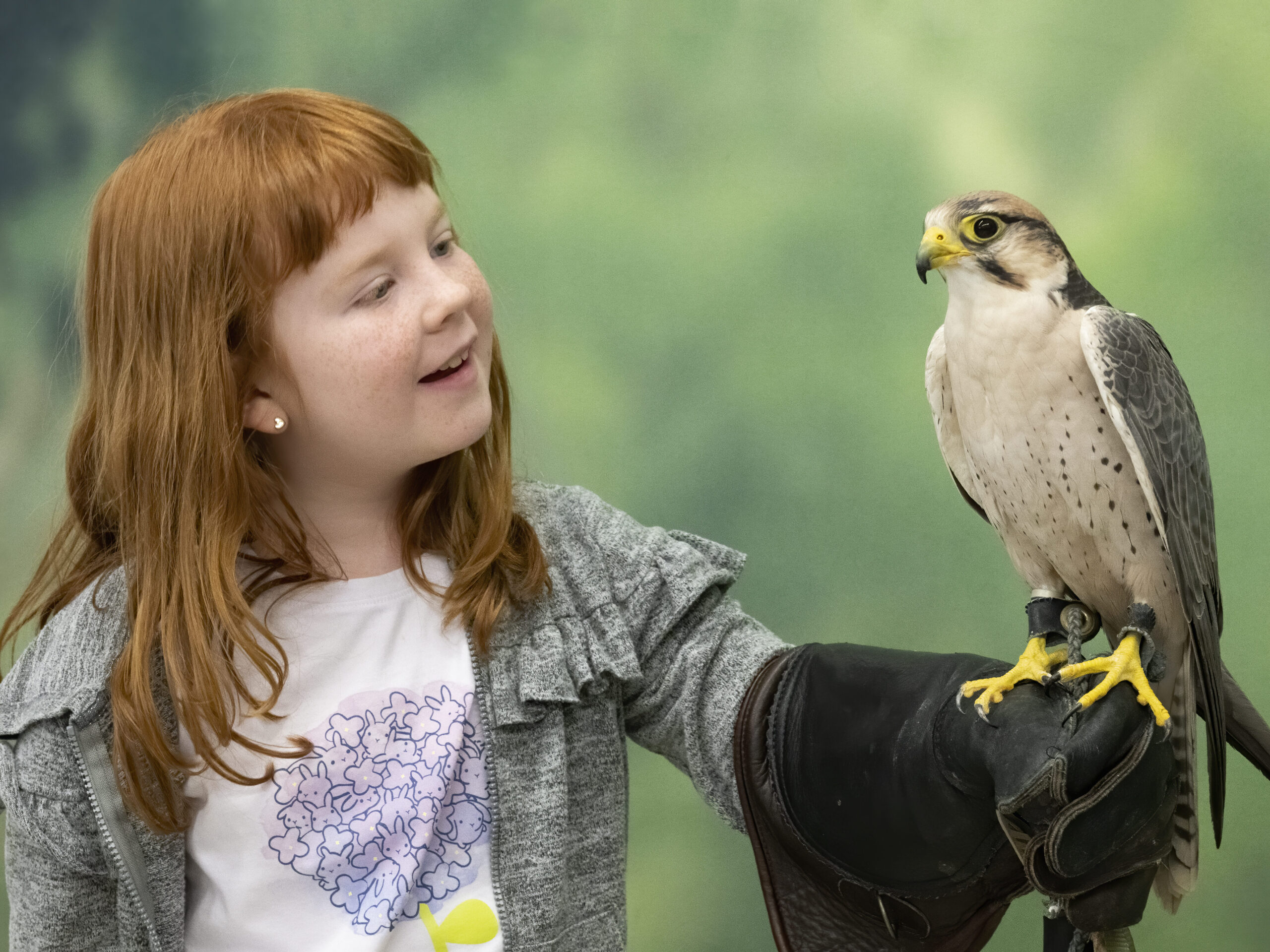
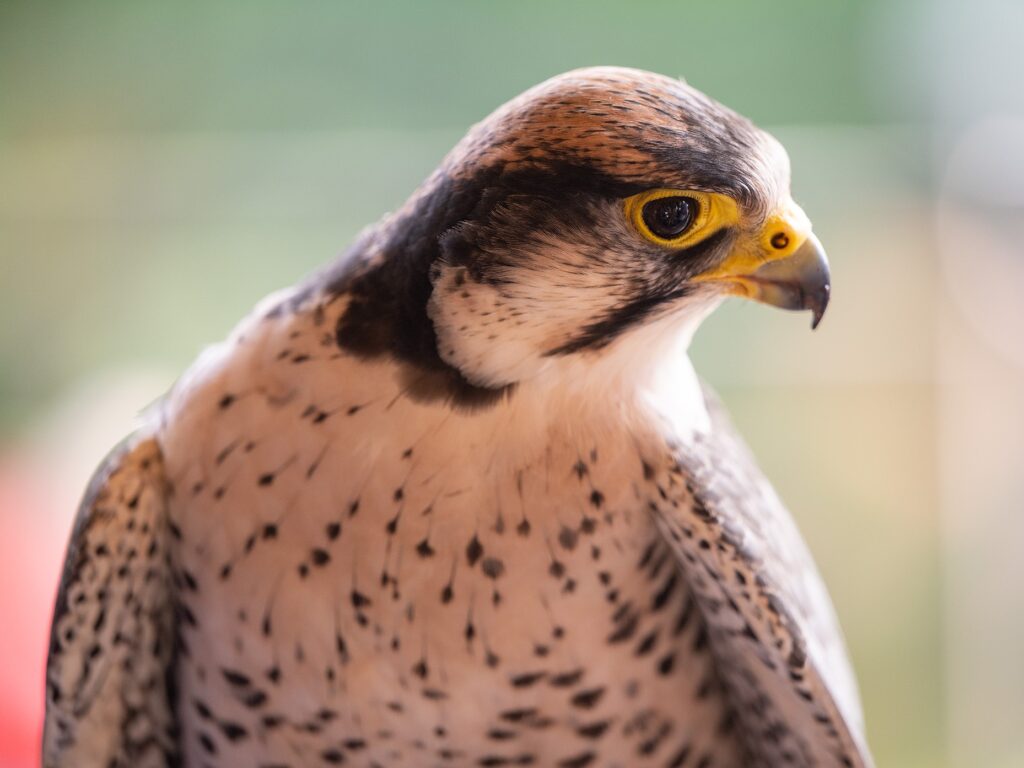
Does watching the National Aviary Peregrine FalconCam make you eager to meet a master of the sky? Get your “falcon fix” and hold a falcon on your gloved hand during a National Aviary Falcon Encounter! Plus, learn the jaw-dropping adaptions that make falcons apex hunters from an Aviary expert.
Falconry: The Sport of Kings
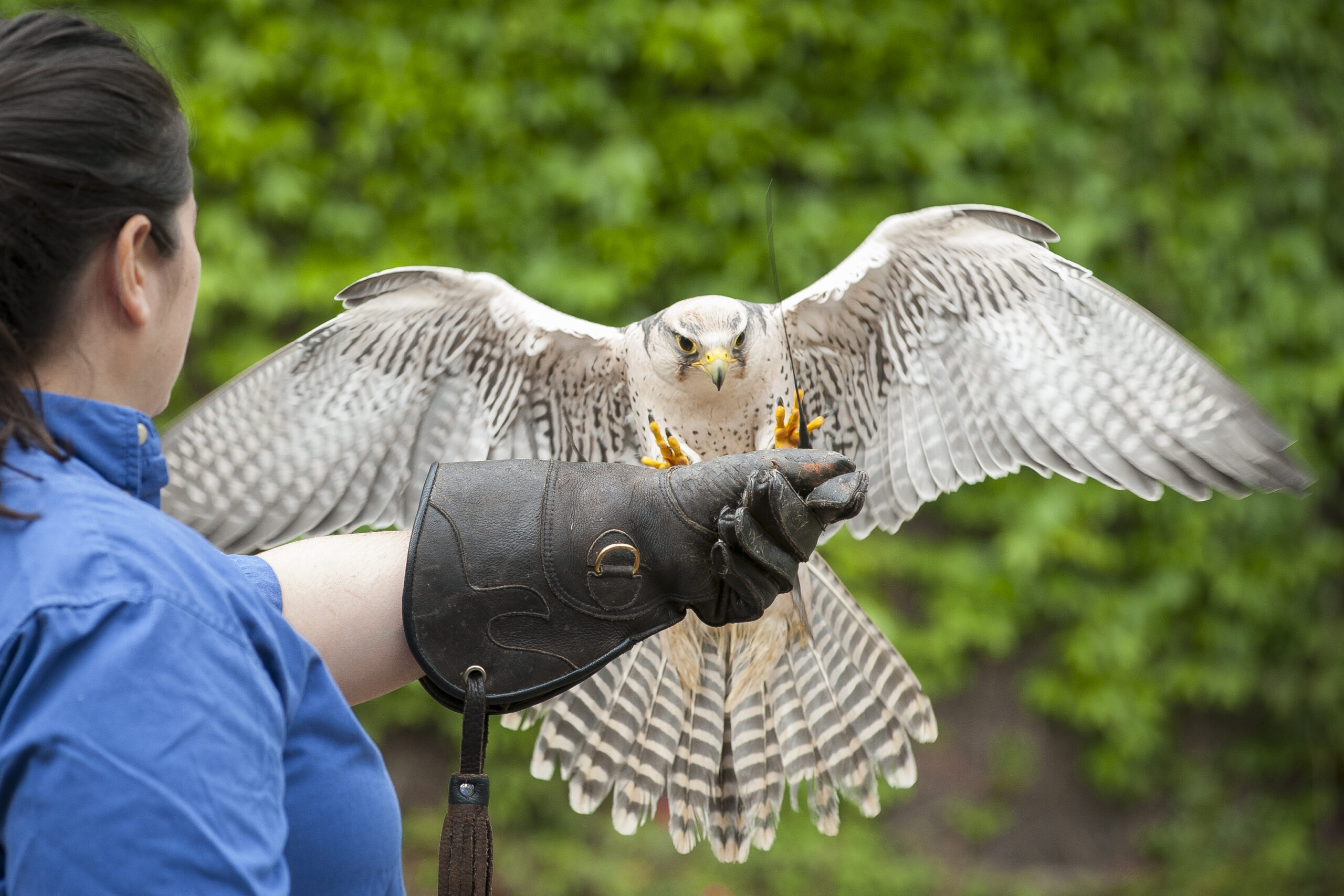
Sat., August 2 | 10 am – 12 pm | Members: $20; Non-Members: $25
National Aviary Admission Included
Dive deeper into the world of falcons! Falconry has been around for thousands of years. Join the National Aviary’s licensed falconer and Director of Animal Programs and Experiences, Cathy Schlott, to discover the rich history and modern-day practices behind this unique sport. Learn about the variety of birds falconers hunt with and the individual consideration in selecting a species while enjoying a visit from one of the National Aviary’s Ambassador Animals.
Register Today!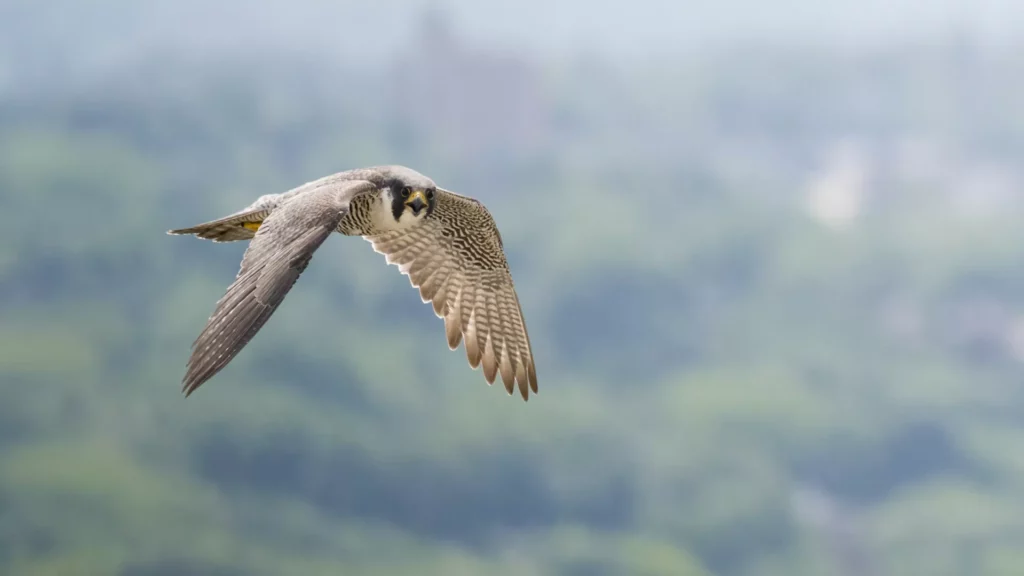
-
2024 Peregrine FalconCam Nesting Updates
2024 marked the first year of Peregrine pair Carla and Ecco occupying the Cathedral of Learning’s next box – and it was exciting! Carla and Ecco’s two chicks BOTH hatched on Earth Day and grew under the watchful eyes of Mom and Dad. As part of an ongoing statewide effort to monitor Peregrine Falcon populations – which were once on the Endangered Species list – Pennsylvania Game Commission biologists banded both chicks in late May. A few weeks later, both chicks fledged their Cathedral of Learning nest – onto their next chapter in life.

Mom, Carla, with her two chicks, April 2024 New Peregrine FalconCam technology made this season’s viewing experience clearer to watch! The updated equipment allowed for a sharper focus, better reach, improved audio, and an infrared night light. We extend a heartfelt thank you to our friends Kate St. John, the University of Pittsburgh, and Lighthouse Electric for the major equipment upgrade!
Updates from the 2024 Peregrine FalconCam Season
June 20, 2024: As the National Aviary’s FalconCam season winds down (the camera stays up through July!), viewers may see parents Carla and Ecco occasionally visiting the nest in case their fledglings decide to return. Those who frequent the University of Pittsburgh’s Cathedral of Learning may spot the Falcon family perched atop the building: the fledglings will stay in their parent’s territory for about four more weeks before their real adventure begins!
The next two years of the fledgling’s journey will be their most difficult as they attempt to tackle thriving in the wild without the help of their parents. After about two years, the two young peregrines will be ready spread their wings into their own territory. Typically, a female will fly farther distances than males to make a new home, than a male, and could potentially find a new territory as far away as Ontario! The Game Commission confirmed during banding that at least the larger of the two falcon juveniles was a female!
Weight is the biggest indicator in determining male and female Peregrines; the female is usually the larger bird. With the smaller of the two juveniles, we will have to wait on officially declaring sex until if and when it decides to start a family of its own (thanks to the banding, we’ll be able to find out where BOTH eventually land!).
National Aviary Ornithologist, Robert Mulvihill remains hopeful about the fledgling’s exciting journey ahead:
“We wish these two young falcons good winging and hope they navigate their natural habitat well and learn the ropes of being independent urban raptors quickly and successfully”, says Robert.
June 4, 2024: The National Aviary’s 2024 Peregrine FalconCam Season is now in full flight! As of June 2, both of Carla and Ecco’s chicks have fledged the nest and can often be seen flying around or perched on the University of Pittsburgh’s Cathedral of Learning! The two chicks, (now referred to as fledglings) will continue to stay in their parent’s territory for up to the next 6 weeks before starting on their new adventure away from home. During this time, parents Carla and Ecco will meet the fledglings wherever they are to bring food to them. Once the fledglings become more confident over the next few days, they will begin to fly to their parents to get their food.
Stay tuned for exciting updates on the fledgling’s whereabouts!
May 28, 2024: Depending on what time of day you tune in, you may notice that one or both chicks aren’t visible in the nest! That’s because they are starting to practice their flight! Keep watching before they eventually fledge and go off on their own adventures.
May 21, 2024: Carla and Ecco’s two Peregrine Falcon chicks were banded at the University of Pittsburgh’s Cathedral of Learning today. The banding of this formerly Endangered species, performed by Pennsylvania Game Commission biologists, is part of an ongoing statewide effort to monitor local Peregrine Falcon populations.
Peregrines essentially disappeared from the east coast 60 years ago, and were on the brink of extinction in the U.S. due to harmful pesticide effects. Conservation measures for the species have been very successful, and the U.S. Peregrine Falcon population quickly recovered. The species was removed from the Endangered Species List in 1999, just 29 years after being placed on the list.
“As the state’s wildlife agency, the Game Commission, joined by several like-minded partners, was heavily involved in this national recovery effort. Banding young falcons is the only way to tell one from another and it enables us to track individual birds while monitoring population trends. We appreciate the University of Pittsburgh and the National Aviary for continuing to engage the public with livestream access to this a high-profile nest site, allowing them to learn more about these incredible birds,” said Pennsylvania Game Commission Endangered Bird Biologist Patricia Barber
The falcon chick banding process takes a short time, but its results offer long-term, positive impacts. By attaching unique, lightweight, numbered, and lettered bands on the chicks’ legs, biologists can learn about their future survival, migratory movements, and perhaps even where they settle down with mates, starting nests of their own.
“This is such an exciting day for the birding community!” says National Aviary Ornithologist Robert Mulvihill. “Bird banding in general is so important to the work that ornithologists like myself and even amateur birders do. It allows us to be able to study birds as individuals using the unique number that the band gives them. These numbers are then entered into a database along with the bird’s movements, survival rate, mating history, and other aspects of biology that make our job that much easier. Peregrine Falcons, specifically, are generally only able to be banded while they are still in the nest, making every opportunity to band them even more precious.”
The National Aviary remains grateful to the University of Pittsburgh, Aviary supporter Kate St. John, and the FalconCam’s presenting sponsor The Birdwatchers Store, based in Slippery Rock, for their continued support of this season’s live FalconCam.
The two chicks are expected to fledge in late May or early June.
May 13, 2024: Carla and Ecco’s two chicks are continuing to make significant steps in their growth and development. As noted by National Aviary Ornithologist Bob Mulvihill, the chicks have started to grasp leftovers in their talons, tearing off bits of food, and can be seen joining their mom on the perch! Additionally, the chicks are now able to stand up straight on their feet, without wobbling very much, a clear sign that they are strengthening their muscles.
May 6, 2024: Dedicated viewers of the National Aviary’s Peregrine FalconCam may have noticed that one egg has not hatched. According to National Aviary Ornithologist Bob Mulvihill, an egg fails to hatch for a multitude of reasons, which can include the embryo not being successfully fertilized, inadequate incubation of the egg, or a defect that interfered with development.
Viewers can still watch Carla and Ecco’s two chicks grow and develop on camera. They’re expected to fledge the nest in June.
April 29, 2024: Sadly, Carla and Ecco’s third chick, which hatched on April 25, has passed away.
According to National Aviary Ornithologist Bob Mulvihill, the chick was experiencing difficulties during feedings and showed other signs it may not survive, such as moving away from the other chicks and facing away from Carla.
Despite this loss, the other two hatchlings are doing well. They continue to grow at a steady rate under the watchful eyes of Carla and Ecco. The fourth egg has still not hatched, and at this point, almost certainly will not. One or more eggs in a clutch failing to hatch is a regular if infrequent occurrence. Amongst monitored Peregrine nests, the rates are shown to be upwards of 40%-50%, a stat attributed to a variety of theories.
April 25, 2024: Come on knock on our door, we’ve been waiting for you…Three’s Company too!
Carla and Ecco’s THIRD egg hatched April 24 around 7:40 pm. Now with three additional mouths to feed, both parents are working diligently to care for their chicks, showcasing amazing teamwork.
Witness the chicks continue to grow on the National Aviary’s Peregrine FalconCam!
April 23, 2024: Surprise! A second chick arrived on Earth Day at the Cathedral of Learning! Carla and Ecco’s second egg hatched yesterday, April 22 at 3:38 pm. Carla is doing an amazing job as a first-time mom, working tirelessly to care for her chick alongside Ecco – viewers might even catch a glimpse of the chicks during mealtime!
April 22, 2024: Viewers of the Peregrine FalconCam are in for an exciting, tiny new arrival! Carla and Ecco’s FIRST chick was seen on for the first time camera around 11:30 am, marking the beginning of a new chapter in the Peregrine Falcon family’s journey. As seen on camera, both parents shared incubation duties for the last three weeks or so, ensuring a safe and successful first hatching. The three additional eggs in the clutch are expected to hatch over the next 24 – 48 hours. As each chick starts to hatch, both parents will provide around-the-clock care during this precious time of early chickhood.
View this precious moment of the new parents with their chick.
Tune back into the FalconCam for updates on this new and growing family!
April 3, 2024: Carla and Ecco are diligently taking care of their nest since their first egg was laid on March 14. As they enter their third week of incubation, we can expect to see Carla on camera in the daytime. Female Peregrine Falcons typically feed at night when they have eggs, however, we have seen Ecco occasionally bring Carla food just before dawn – taking over incubation while she eats.
Incubation will continue for roughly another three weeks, with potential hatchings occurring in early spring around Earth Day (April 22). Tune into our Peregrine FalconCam and follow along on our social channels for updates!
March 21, 2024: Carla laid her fourth egg this morning at 10:25 am. Peregrine Falcon clutches typically consist of four eggs and the incubation period is 33-34 days. We will likely begin to see more of Carla on camera as she continues to care for her eggs.
Check out this heartwarming moment our Peregrine FalconCam captured between Carla and Ecco, with all four eggs in sight.
March 19, 2024: Happy First Day of Spring! Carla and Ecco have a third egg! Carla laid this egg in the early hours of March 19 at 2:01 am EST. Peregrine Falcon incubation typically begins when the female has laid her next-to-last egg.
March 18, 2024: The second egg from Peregrine Falcon pair Carla and Ecco has arrived! Carla laid her second egg on March 16 at 9:08 pm EST.
Peregrine eggs are tolerant to various temperatures and can sit uncovered in the nest box over the next several days. Viewers can expect to see a third egg in 48 hours.
March 14, 2024: Viewers of the Peregrine FalconCam may have recently noticed an exciting new addition! The first egg from Peregrine Falcon pair Carla and Ecco has officially arrived! Carla laid her first of up to four eggs on March 14 at 4 pm EST. A Peregrine Falcon clutch typically consists of four eggs.
As seen on the live stream, Peregrine Falcon eggs are fairly smooth with no gloss. The color of the eggs varies from a pale, creamy color, to a deeper brown.
From here, Carla will potentially lay one egg every 48 hours up to her last egg. Carla will know when it’s time to start incubating and won’t begin until the second-to-last egg is laid. We may see Ecco temporarily help to cover the eggs in inclement weather to allow Carla to rest.
She’ll continue to incubate for 33-34 days before hatching and that’s when the exciting prospect of raising chicks will begin!
February 27, 2024: As Peregrine FalconCam season continues, viewers may have recently noticed several visible bones in the nest box. Peregrine Falcons typically consume pigeons, songbirds, and other flying birds as a part of their diet. The bones seen in the nest box are likely a result of meals in past years. They have probably become more visible due to Carla and Ecco’s activeness at the site.
A healthy diet is vital to the well-being of the falcons and will ensure they are strong in preparation for potential breeding activity.
February 12, 2024: The start of Peregrine FalconCam season may initially appear to be uneventful; in fact, it’s a window into the development of Carla and Ecco’s budding relationship that will grow with every nest box visit.
In a recent session taken on our Peregrine FalconCam livestream, we saw the pair demonstrating strong courtship behaviors. As you watch, the birds are shown practicing Mutual Ledge Displays which include simultaneous Horizontal Head-Low postures and vigorous “ee-chipping” vocalization. Mutual Ledge Displays will increase as the nesting season progresses. We will continue to keep an eye out for additional postural changes such as the Head-Low Bow, in which Ecco will be seen approaching the nest also known as “scrape” while making the same excited “ee-chip!” vocalization heard in the Mutual Ledge Displays.
February 1, 2024: Peregrine FalconCam season is back! Last year marked the third one for Peregrine pair Morela and Ecco at the Cathedral’s nest box. For several days in mid-March, it appeared as if Morela was close to laying eggs, however, the season ended without any eggs. Morela’s last appearance on camera was caught in early May 2023. New banded female, Carla, laid claim to the nest box and mate Ecco shortly thereafter.
New National Aviary Peregrine FalconCam technology will make this season even clearer to watch! With the help and support of our friends Kate St. John, the University of Pittsburgh, and Lighthouse Electric, a new microphone and camera equipment were installed on the Cathedral. This updated equipment allows for a sharper focus, better reach, improved audio, and even an infrared night light!
This new setup provides a great view into the world of Peregrine Falcons, like Carla and Ecco. This is the pair’s first full nesting season on camera. She and Ecco have demonstrated courting behaviors at the nest over the last few months and we hope to see the two continue to develop their relationship. Viewers can expect to see the breeding pair continue to acclimate to one another through vocalization and postural changes.
-
2023 Peregrine FalconCam Nesting Updates
2023 marked the third year of Peregrine pair Morela and Ecco occupying the Cathedral’s nestbox. For several days in mid-March, it appeared as if Morela was close to laying eggs, however, she never did. Morela made her last appearance on camera in early May 2023. New female, Carla, appeared on camera for the first time not too long after. We can all look forward to the 2024 National Aviary Peregrine FalconCam season: we will see if Carla and Ecco join us for it.
May 19, 2023: On Sunday, May 14, we moved our cam around to see if Morela might have taken refuge underneath, as it appeared in recent sightings that her speculated egg-binding episode left her in a weakened state. After several minutes of searching, she was nowhere to be found. Since then, Morela has not been seen on camera.
That same afternoon, Kate St. John alerted everyone through her Outside My Window blog that resident male Ecco was sunbathing on the nest platform. Shortly after, a new female appeared. She just happened to display her banded right leg very clearly. Kate did some research and learned that she was female Black/Blue S/07, banded on three years ago on May 18, 2020, as a nestling on a building at One Summit Square in Fort Wayne, Indiana! She even has a name: Carla.
While don’t know if Carla has become Ecco’s official new mate, we suspect that she has. We are sad about the difficulties that led to Morela’s leaving, though we look forward to more nesting activity at Pitt in the seasons ahead. It is highly unlikely that Ecco and Carla will attempt to nest this season, but we’ll be keeping an eye on the FalconCam anyway…just in case!
May 3, 2023: As was noted recently in Kate St. John’s “Outside My Window” blog, it, unfortunately, looks very likely that there is not going to be a nesting attempt at the Cathedral of Learning nest on the Pitt campus this year.
Although the female, Morela, and her mate, Ecco, seemed to be going through the motions appropriately, they did appear very distracted from time to time. This usually indicates that there is a third Peregrine of either sex probing into their territory. This, in turn, likely required them to spend a lot of extra time being vigilant and defensive of their nest site.
Back in March, it appeared Morela was close to laying. However, we recently posited that it appeared Morela has had physical difficulty laying her eggs this season. She often sat in position for long periods of time but with no result. This particular condition is known as egg-binding. Egg-binding, or dystocia, is the failure of an egg to navigate through the oviduct in an appropriate time frame for a particular species. Causes of egg binding and retention include environmental stress (e.g., large temperature fluctuations, excessive noise, and lack of appropriate seclusion). One theory, then, is that the stress of a third bird in their territory may have induced the egg-binding episode that we believe we are seeing.
In Morela’s case, we think that there are signs she was able to expel the inviable egg. Although a falcon could possibly recover and lay following an egg-binding experience, the lateness of the season makes that possibility less likely.
Again, egg binding can stem from environmental stress; in fact, that stress could have been the presence of a competing bird, male or female, during a critical stage of egg laying. We will keep monitoring for several more weeks.
It’s important to remember that these nest cams give us a view into the wild world of birds, and while it is not our role to intervene, we can learn a lot from watching and documenting these behaviors.
April 20, 2023: This is the third year for the Peregrine pair, Morela and Ecco, nesting at Pitt’s Cathedral of Learning. Last year they laid their first egg on March 18 and on March 17 in 2021. Clearly, something is going on that is interfering with their normal nesting progression. It could be a third Peregrine of either sex that is creating a disturbance to Morela and Ecco’s nesting progress, as we think happened in 2020, when Morela was being courted by both Ecco and the former male from the site, Terzo. That year she did not lay an egg until May, and she abandoned it when neither of those males helped her at the nest.
What we are seeing now seems similar to the 2020 season. Of course, we can only observe what is happening right there at the nest, and there must be a lot that is happening away from the nest. Fingers crossed that whatever drama is delaying nesting this year will resolve in time for Morela to have a successful, albeit later than usual, nest this year.
March 29, 2023: We can never predict what will happen in the worlds of wild birds. For several days, Morela appeared to be close to laying eggs: she was less active at the nest and her feathers were fluffed out. But, after a few days of relative inactivity, she seemed to be very alert, intently watching the sky, and was gone from the nest for long lengths of time. We have now passed the date by when we usually have seen one or more eggs laid, which raises the question of what is different this season?
One possibility is that an unmated Peregrine without a nest is intruding on the territory, and its presence has Morela on high alert and is keeping her away from the nest. Of course, something else entirely may have captured her attention for a few days. Whatever is the case, now Morela and Ecco seem to be resuming their courtship activities. Both have made visits to the nest site and have been observed bowing toward each other – one of the many characteristic courtship behaviors of Peregrine Falcons. These are the sorts of natural occurrences that nest camera technology helps us document and better understand. We will have to stay tuned to see where things go from here.
March 15, 2023: If you’ve noticed Morela looking a little lethargic lately, it might be because egg-laying is right around the corner. Around five days before they begin laying, females are not as active: they aren’t preening themselves as often or moving around stones in the nest scrape, and they spend a good deal of time sitting on or near the scrape. Basically, they look like they’re just waiting for something to happen!
You might notice a change in Morela’s posture, too. These days, she is looking noticeably bottom-heavy, and the feathers under her tail are fluffed out. She will lay one egg every 48 hours up to the penultimate, or next-to-last egg (a Peregrine Falcon clutch usually has four eggs). The period between the next-to-last and last egg often is a bit longer, up to 72 hours, and only Morela will know when it’s time to start incubating.
She won’t begin until the second-to-last egg is laid. Ecco will assist with incubation, freeing up Morela to hunt, but expect to see her on the nest more often than Ecco: females spend about twice as long incubating the eggs compared to males. They’ll take turns incubating for 33-35 days before hatching—and the real fun of raising chicks!—begins.
February 27, 2023: The first few weeks of the Peregrine Falcon nest cam season can be pretty quiet, but don’t expect that to last long! As we get closer to nesting time, Morela and Ecco are visiting the nest box more often and staying longer. You may catch them together on camera perching on the nest’s ledge or in the nest itself (also called a “scrape”) as they bow towards each other. These behaviors are part of their courtship and help strengthen their pair bond. It’s easy to tell Morela and Ecco apart when they’re side by side: Morela is noticeably larger than her mate, a common characteristic of many raptor species.
This is the third year Morela and Ecco will be nesting at the Cathedral of Learning. Together they have fledged seven young (4 in 2021, and 3 in 2022). If this nesting season is anything like previous years, we can expect Morela to lay her first egg sometime around St. Patrick’s Day. Until then, watch for Morela and Ecco’s visits to the nest for a chance to observe their courtship behaviors
-
The History of Peregrines at Pitt
2002 – Spring 2015: The Cathedral of Learning at the University of Pittsburgh has hosted a pair of Peregrine Falcons since 2002, when “Dorothy” began nesting here with a tiercel (male falcon) named “Erie.” In the fall of 2007, after Erie disappeared, another male (“Erie II”, or “E2”) took over. Dorothy fledged a total of 43 chicks, 22 with Erie and another 21 with E2. She disappeared in the fall of 2015 at age 16, which is very old for a Peregrine Falcon.
Fall 2015 –2019: In November 2015 a new female, “Hope,” arrived at the Cathedral of Learning from her former nest site at the Tarentum Bridge (about 12 miles away) where she had fledged at least four young. Hope’s initial mate was E2, succeeded by “Terzo” when E2 died in March 2016. Hope nested at the Cathedral of Learning for four seasons, 2016 through 2019, during which time she displayed aggression toward her chicks. Hope’s behavior was very unusual. She raised 8 offspring to fledging age, out of 16 total hatchings. We, and the experts we have consulted, have no explanation for Hope’s highly unusual behavior.
Fall 2019 – 2023: In September 2019 a new unbanded female Peregrine arrived at the Cathedral of Learning, named Morela (Polish for “apricot”) for the distinctive apricot-colored wash on her chest and face that makes her recognizable on camera. Because she is unbanded, we don’t know where she came from. Morela and Ecco raised their first clutch, fledging four chicks in 2021, and another four in 2022.
Many thanks to our partners: University of Pittsburgh, M&P Security Solutions, and the Pennsylvania Game Commission.
-
More About Peregrine Falcons
Peregrine Falcons are the world’s fastest animal, capable of diving at speeds of over 200 miles per hour! These fierce birds of prey grow quickly, too. Peregrine Falcons nest on cliffs or ledges of tall buildings where they lay a group of up to four called a “clutch”, in a bowl-shaped depression in gravel.
The female Peregrine incubates the eggs for about a month, sitting on them to keep them warm. During this time, the male brings food for the female – ensuring that she stays with the eggs to keep them warm. When the chicks hatch, they are small, nearly featherless, and very dependent on their parents. But, they mature very quickly, and within a week of hatching they nearly double their size! Within a month, they go from having soft, downy white feathers to dark brown feathers, or plumage. By around 5 weeks old, they are ready to fledge the nest! Peregrine Falcons stay with their parents through the beginning of summer, learning to hunt and navigate their world.
For more news about all of Pittsburgh’s Peregrine Falcons, visit Outside My Window, Kate St. John’s Bird Blog. Thank you, Kate, for your continued support of the National Aviary Peregrine FalconCam.
The National Aviary would also like to thank the University of Pittsburgh’s Dietrich School of Arts & Sciences, the Department of Biological Sciences, and Rory Carroll for their installation support of the new camera in 2024.
Questions about Peregrine Falcons and other wild birds? Contact [email protected].
Did You Know…
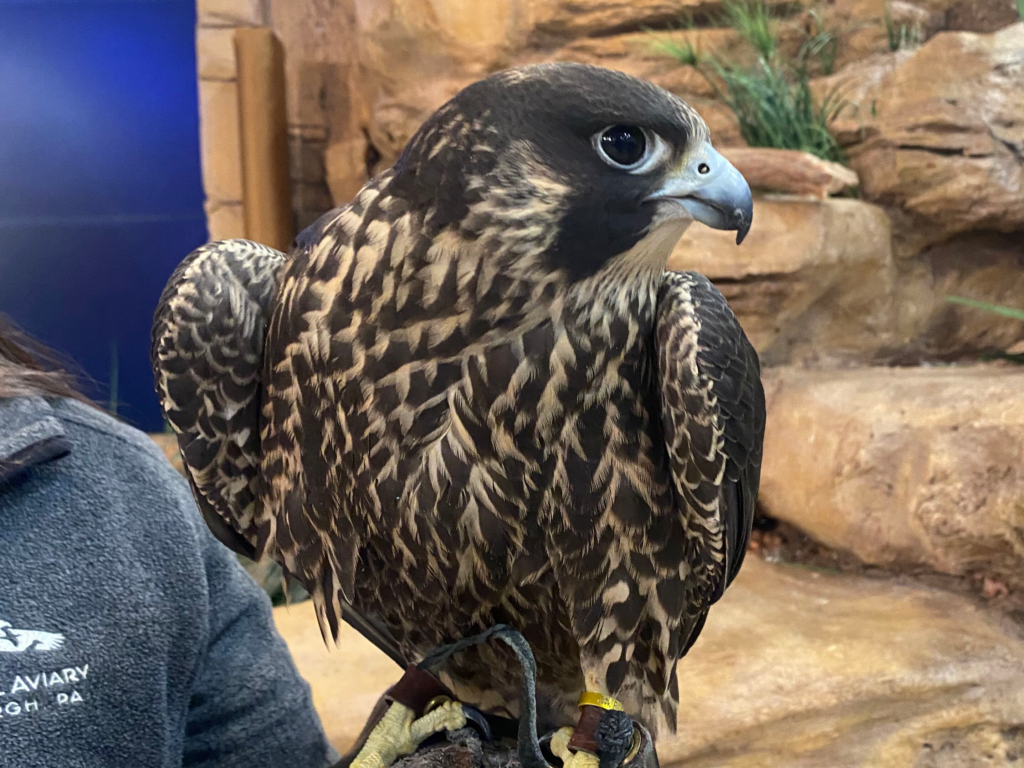
…the National Aviary is home to a Peregrine Falcon?! Want to learn how you can get even closer to him and uncover the adaptations that make his species oh-so talon-ted? Call 412-258-9439, email [email protected], or fill out our Adult Group Inquiry Form!
Interested in planning a Field Trip to the National Aviary, or having an Aviary expert visit your school? Learn more here!
